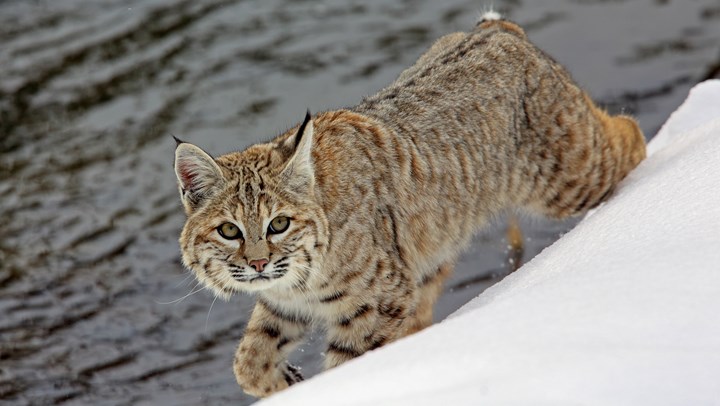
by Keith Crowley - Saturday, October 7, 2017

There have been some great wildlife recovery stories in Wisconsin in the past few decades: wild turkey, elk, Sandhill cranes, bald eagles and even the gray wolf have all reached sustainable population numbers due to the successful programs put in place to help recover these wild game species. Most recently, the bobcat has made a remarkable recovery, thanks to the efforts of hunters, trappers and biologists.
Where once there had been unregulated hunting and even a bounty on the reclusive cats, by 1964 there were few left in the state. Like the elk, cranes and turkey before them, bobcats were essentially extirpated from Wisconsin’s landscape. In 1970, a formal management plan began and by 1980, bobcat population numbers had risen enough that a carefully regulated harvest system was established.
In a recent report provided to the Wisconsin Natural Resources Board, researchers presented positive news regarding the future of bobcats in the state. According to a recent Milwaukee Journal Sentinel article, Wisconsin Department of Natural Resources (WDNR) furbearer specialist Dr. Nathan Roberts told the board that bobcats are “a true Wisconsin success story.”
In 1980, biologists believed there were approximately 1,500 bobcats in Wisconsin. That number is now approximately 3,500. Put simply, the bobcat population is thriving. While bobcat populations vary somewhat with the availability of prey—mostly hares, rabbits and rodents—the trend continues to rise. As a result of the increasing population numbers, wildlife managers recently have increased harvest limits, due in large part to help from Wisconsin trappers who volunteered their time and efforts to help the WDNR collar the cats with GPS tracking devices. The information obtained through tracking research has been instrumental in determining current population levels.
“The DNR works closely with trappers and hunters to learn more about this elusive, but [now] common, species—together, we are working to refine our understanding of Wisconsin's bobcat population and are finding that Wisconsin's bobcat population is healthy and robust enough to provide additional harvest opportunities," said Roberts in a recent WDNR news release.
In a WDNR article on the collaring program, Roberts and co-author Nick Forman explain just how closely the biologists are working with trappers:
“The bobcats being collared by researchers are, in large part, voluntarily reported by trappers who incidentally catch bobcats during efforts to trap other species. The trappers are eager to learn more about the population and enthusiastic to have research staff come out to collar the animals.”
Hunters currently have a dedicated bobcat season in Wisconsin and permits are obtained through a preference-point lottery system. Hound hunting and calling in the cats are both popular hunting methods and allow for selective harvest of the furbearers.
Roberts noted that contribution from sportsmen and women is critical to his research: “We get information from hunters and trappers when they fill out surveys describing their success rates: their effort and their catch. Successful hunters and trappers also provide us with carcasses that yield a wealth of information. All these clues help us piece together a picture of how bobcats are doing.”
Wisconsin hunters and trappers also supported a fee increase for bobcat permit applications in 2009 during the annual Conservation Congress Hearings held each spring on a county-by-county basis. The question asked of Wisconsin outdoorsmen and women at the hearing was: “Would you support legislation adding $3 to the bobcat permit application fee and have it earmarked for bobcat research and management?” Despite the fact that this effectively doubled the application fee, hunters and trappers agreed and answered “yes.”
On average, more than 10,000 Wisconsin hunters and trappers apply for permits each year, creating a substantial revenue source for continuing research. Combined with matching federal grants through the Pittman-Robertson Act, the increased funding has allowed Roberts and his fellow researchers to put GPS collars on more than 60 bobcats since 2014. The data provided by the latest research indicates that the cats are doing better than expected—allowing for additional harvest opportunities for sportsmen and women.
So just how crucial are Wisconsin hunters and trappers to supporting bobcat research and management? “From funding to implementation, this work couldn’t be done without the interest and support of the hunters and trappers in our state,” said Roberts.
While the latest research indicates that bobcat populations in the northern half of Wisconsin are thriving, cats are starting to show up with more frequency in the southern portion, too. Studies are underway to help estimate population numbers in the southern zone, which are currently unknown.
Bobcats are challenging to find and research, but thanks to the efforts of Wisconsin hunters, trappers and scientists alike, we are learning more about the cats every day. As is the case with so many wildlife success stories, the relationship between sportsmen and women and wildlife managers is critical to that continued success.
E-mail your comments/questions about this site to:
[email protected]
Proudly supported by The NRA Foundation and Friends of NRA fundraising.
